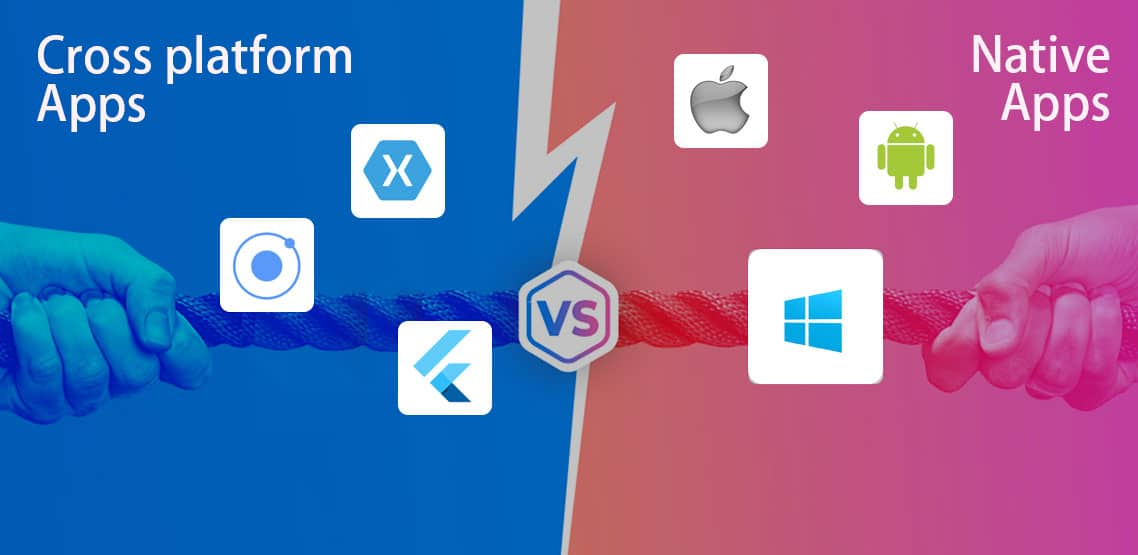Table of Contents
How to Build Cross Platform Mobile Apps
Author

Date

Book a call
Mobile devices have become a crucial aspect of our daily lives, and businesses have realized the significance of developing a mobile app to increase their outreach to customers. However, creating an app for each platform can be costly and time-consuming.
Cross-platform mobile app development is an effective solution to this challenge. In this blog, we will discuss how to build a cross-platform mobile app, providing you with the confidence needed to take on this task with ease.
Difference Between Native and Cross-platform App Development

Native app development requires creating a separate app for each platform, such as iOS or Android. It involves expertise in platform-specific programming languages, tools, and software development kits (SDKs). That means a single application has to be built twice.
On the other hand, cross-platform app development streamlines the process by allowing developers to write a single codebase that can run on multiple platforms. By using frameworks that enable developers to create apps using common languages like HTML, CSS, and JavaScript, cross-platform development can be more efficient than native development.
Benefits of Cross-platform Mobile App Development
Cross-platform mobile app development has numerous advantages over native app development:
- It offers a cost-effective and time-efficient approach to producing mobile apps for multiple platforms
- Using cross-platform development, enterprises can expand their reach and enhance customer engagement
- Cross-platform development reduces development costs
- It enables simpler maintenance and updates
- Developers can make changes to a single codebase instead of updating separate codebases for each platform.
To take advantage of these benefits, you need to follow the correct development cycle. These steps will help you learn how to do it.
Key Steps to Follow While Building Cross-platform Mobile Apps
1. Define the idea and purpose of the app
- Identify the target audience and their needs.
- Determine the app's features and functionality.
- Analyze competitors' apps to identify unique selling points (USPs).
2. Choose a cross-platform development framework
- Research and compare popular frameworks such as React Native, Xamarin, Flutter, and Ionic.
- Evaluate each framework based on language, performance, community support, and ease of use.
- Select a framework that meets the project requirements.
3. Pick a programming language
- Determine the programming language based on the selected framework.
- Consider factors like familiarity, readability, and maintainability.
- Select a language like Dart, Javascript that supports the required features and provides adequate support.
4. Design the user interface
- Create a wireframe or prototype of the app's interface.
- Ensure that the interface is user-friendly and intuitive.
- Test the interface with users and gather feedback.
5. Develop and test the app
- Write code based on the design and features.
- Test the app using emulators, simulators, or physical devices.
- Debug and fix any issues identified during testing.
Following these steps, you can confidently create a successful cross-platform mobile app that perfectly meets your business needs. Remember to thoroughly test and iterate the app based on user feedback to enhance its performance and functionality continually.
Industry Leading Frameworks for Cross-platform Development

There are several highly regarded, code-based, cross-platform development frameworks available. This includes React Native, Xamarin, Flutter, and Ionic.
- React Native is a popular framework that allows for developing mobile apps for both iOS and Android platforms.
- Xamarin utilizes the .NET framework and enables coding in C#.
- Flutter, Google's open-source framework, uses the Dart programming language.
- Ionic frequently uses web technologies like HTML, CSS, and JavaScript.
Challenges
Cross-platform mobile app development offers several benefits, but it also presents its own set of challenges. The biggest challenge is ensuring the optimal performance of the app across all platforms.
Also, since cross-platform development uses a single codebase, developers must ensure flawless functionality across different devices and operating systems. Furthermore, cross-platform development may only support some of the features available on each platform.
Conclusion
Cross-platform mobile app development is presently the best solution for businesses that want to create a mobile app for multiple platforms. It offers numerous benefits over native app development, such as cost-effectiveness, time efficiency, and easier maintenance.
The method does have certain hiccups, but by following the steps outlined in this blog, businesses can create a successful cross-platform mobile app that meets their needs precisely.
Do you want to create an app without spending a lot of money? GeekyAnts can help. Our talented developers will work with you to create a great app that meets your needs. Get in touch with us today to get started!
Dive deep into our research and insights. In our articles and blogs, we explore topics on design, how it relates to development, and impact of various trends to businesses.





